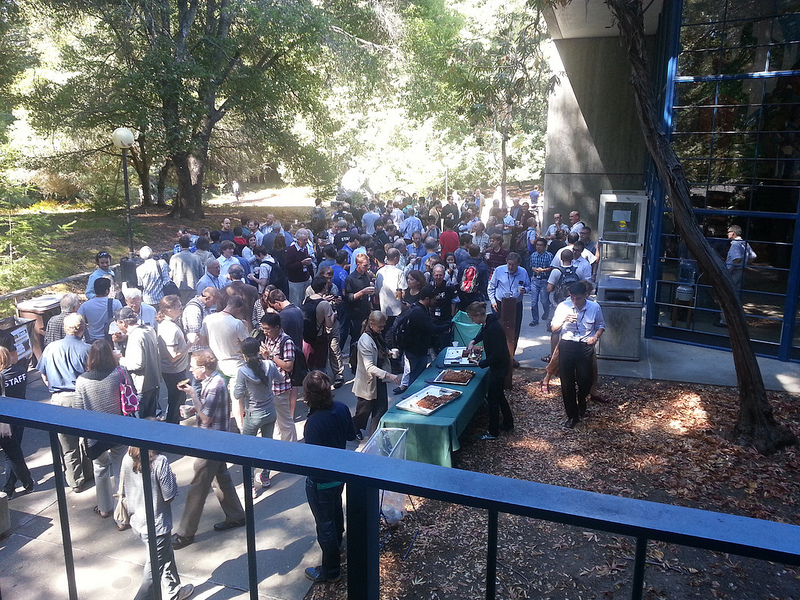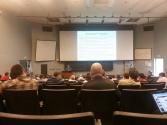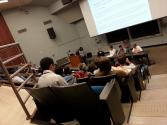Meeting of the APS Division of Particles and Fields
August 13, 2013 to August 17, 2013
Santa Cruz, CA
Meeting host: By:Elwin Martin
SPS Chapter:

This August I attended the meeting of the Division of Particles and Fields (DPF) at the University of California at Santa Cruz. I was there primarily to present recent research results from my work on flavor-changing neutral-currents, but I also went to meet potential graduate advisers and learn about different graduate schools from the students of the schools present. The main results I presented were approximate cross sections at leading, next-to-leading, and next-to-next-to-leading order for processes in which a top quark becomes an up quark through the emission of a photon or a Z boson. The meeting isn’t all about research, though.
The DPF meeting is a biannual event in which the state of High Energy Physics (HEP) is discussed; two days of plenary talks give overviews of the recent results across the various "frontiers" in HEP and two days of parallel session talks dig into the results of particular individuals and collaborations. The creation of different factions within physics known as “frontiers” is a relatively recent construct of the Department of Energy which was intended to better organize how research funds are distributed within the field. Unfortunately, this organizing scheme has the effect of creating artificial barriers between HEP physicists and creates competition where it perhaps should not be. The nature of the frontiers and their usefulness as a concept was often discussed both in talks and in the question sessions at the meeting.
This year's meeting was focused on the results from the Snowmass meeting the previous week. Snowmass is important because it laid the groundwork for the goals the community hopes to meet over the next ten years. Accordingly, the plenary talks this year were based on the summary talks given at the end of Snowmass, often constructed with slides taken from those talks. Among these, my favorite was actually the first delivered, given by Dr. Michael Peskin from Stanford. The title of the talk asks an important question: “What have we learned at the Energy Frontier?” I liked this talk not only for the physics, which I’ll address in just a moment, but also because it laid the groundwork for the meeting and answered many of my questions about Snowmass, DPF, and the organizational structure of funding in HEP. The takeaway message from his discussion on this front was that there are many ideas for the next machine to be built, too many in fact. There has been a fairly constant desire for higher energy particle accelerators since the early days of synchrotrons, but the funding climate will only allow for investment in a handful of the ideas proposed at Snowmass. The goal of DPF this year was to digest ideas like those presented on new machines and use that information to nail down the communities priorities. With respect to the science, Dr. Peskin outlined three main facets of the energy frontiers future: searches for heavy particles, searches for new physics through W, Z, and top physics, and searches for new physics through the Higgs boson. While the searches for heavy particles may or may not appear plausible with presently attainable energies, there is much work to be done with precision higgs and electroweak physics as a whole.
The parallel sessions consisted of everything from accelerator design to string theory. I attended talks on the top quark, beyond the standard model phenomenology, field and string theory, and flavor physics sessions. In the top quark sessions I felt particularly comfortable. This was mostly due to my research experience and familiarity with the literature, but the group of presenters soon became familiar. It was clear that the attendees and presenters usually knew one another, but were willing to welcome new people to the top quark research community. For me, the highlight of these sessions was a talk by Dr. Joshua Berger from SLAC. The title of the talk was “Up Sector Minimal Flavor Violation” and the main result was that there could be new particles with energies less than 100 GeV with distinctive signatures visible in top decay and production in minimal flavor violating models. The talk was particularly interesting to me for the algebraic properties of the model constructed and the discussion of different effective operators which could play a role in charge parity violation.
Another favorite of mine was a talk by Jason Kumar from the University at Manoa. “Dipole Moment Bounds on Dark Matter Annihilation” is just one of the many excellent examples of the versatility of data. Kumar should how data on the gyromagnetic ratio of the muon and the electron dipole moment can be used to constrain scalar dark matter mediated by a fermion. Additionally, Kumar did the audience an enormous favor by keeping the assumptions of his model in color coded boxes, which appeared where relevant and in his concluding slides. By keeping everyone on the same page with his assumptions, he made especially clear the domain in which his results are of use.
In the realm of flavor physics, Dr. Wei Chen’s talk “Charmonium and Bottomonium Hybrid States” was particularly cool. The quark model is inherent in the way that most of the HEP community thinks about quantum chromodynamics, except for perhaps among those who work with lattices. Among the central tenets of the quark model is the notion that the only bound states of quarks are mesons and baryons, which are composed of two and three quarks respectively. This is a convenient way of thinking, but this is not a rigorous result of the mathematics. There exists still the possibility for exotic hadrons, such as dibaryons, tetra- and pentaquark configurations, meson molecules, glueballs, and hybrid mesons. The focus of Dr. Chen’s talk was explaining the spectrum of masses produced by the hybrid mesons, bound states where the inner dynamics of a quark-antiquark pair are complicated by a gluon binding them. The composite particle acts a sort of excited meson state. Flavor physics is something that has always sounded cool to me, but that I had never really had to the opportunity to learn about and this talk gave me a good introduction to some flavor physics and the specifics of hybrid meson research.
The meeting was great for learning about the forefront of research in HEP and the directions that look most promising in the coming decade, but there was an important social component that cannot be neglected. To begin with, the DPF meeting this year was different from many meetings in that all meals were provided in addition to the traditional coffee breaks. While this was actually a deterrent to some as it increased the cost of registration, it gave the participants more time to interact and removed the worry of finding food and one’s way around Santa Cruz. During the lunches provided there were presentations on materials outside the realms of research. Dr. Sarah Demers from Yale gave a great overview of gender bias in physics, though the emphasis was on unconscious bias in science as a whole. While there was noticeable apprehension about having a discussion about something so serious during lunch, Dr. Demers kept the discussion comfortable by presenting the issues in a light and balanced manner. Unconscious bias plagues science from the impact on high school classrooms to faculty hiring and it’s important that we understand how our efforts, or lack thereof, impact gender equality.
Along with the food and the discussion that accompanied it, there was a “Young Physicists’ Forum” - ‘young’ meaning somewhere between undergrad and early postdoc. The panelists came prepared to discuss three primary themes: how young academics can be successful in an academic environment where the measures of success are changing; how we can ensure productivity and motivation when academia as a career is not attainable for the vast majority; how we can encourage young researchers to have an impact on the field.
The discussion was surprisingly pessimistic at times, though not the fault of the panelists. A recurring theme in the questions was evaluating the timing for one’s exit from academia. Questions like “How many postdoctoral positions before I know I should quit?” or “How many years of total time in ‘x’ position?” gave me the impression that young physicists are far from naive, we border cynical. The chatter wasn’t all gloomy though. Important questions regarding how to distinguish oneself in a large collaboration and on the opportunities available in national laboratories were addressed as well. The most important thing to do, according to this panel, was to become the collaboration expert on whatever you do best. I think this advice is salient even in much smaller organizations and the idea of striving for mastery of a relevant and useful skill in one’s research group is one which I will keep in mind.
One of the more interesting parts of the conference was the inclusion of a public talk by Dr. Hitoshi Murayama. While the material was covered in the traditional glittery manner that is present in a public lecture, I was incredibly impressed by the quality of the analogies used. The talk was especially cool for me since I got to speak with Dr. Murayama briefly and Dr. Peskin took my photo with him. The enthusiasm that Dr. Murayama had for explaining things, even after giving his talk, was infectious and I am glad I attend even though the material was not new for me.
Overall, I think the most important thing I learned from this meeting was that the high energy community is a wonderful one, despite the rather extreme competition. DPF 2013 was a wonderful experience and I look forward to returning as a graduate student in 2015.
About me:
Greetings reader! My name is Elwin Martin and I’m a physics major at the Georgia Institute of Technology (GT). I’ll be finishing my degree this fall and have been surveying my options for graduate school with an open mind. I have been an SPS member nationally for two years, and a member of the GT chapter for a little over a year now, and have greatly enjoyed the benefits of membership. When I’m not doing physics I try to listen to music and relax with friends. The GT SPS has existed for decades, but most of this history has been lost in poor bookkeeping and crude transitions of leadership. The modern incarnation has existed for roughly four years and is currently lead by our president Casey Trimble. We give back to the community by running panel discussions amongst GT faculty on big questions in physics, such as our spring 2013 panel “Understanding Nature through Reductionism”, and give fun science demonstrations at local elementary schools. I take an active role in my SPS by running a weekly video series, titled "Cool-Like-Carl" in memory of Carl Sagan, which showcases educational and inspirational video content in physics and related fields.
[1] αS refers to the “strong coupling” of Quantum Chromodynamics, the parameter which tells one the strength of QCD at a given energy; Z refers to the Z boson, the neutral electroweak mediating boson.



